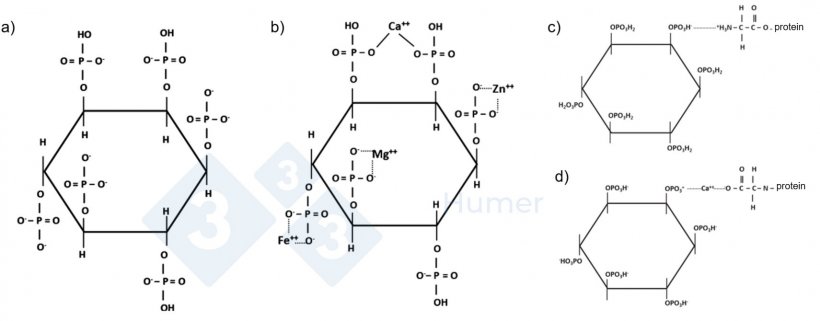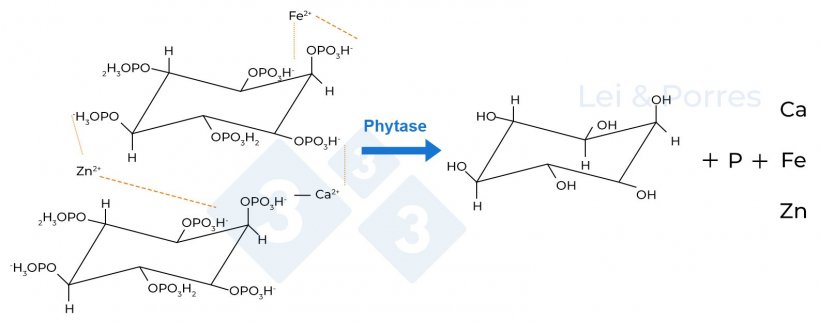Phosphorus (P) is an essential mineral for bone mineralization, energy metabolism, and nucleic acid synthesis. In swine nutrition, it is the second most abundant mineral after calcium and the cost is high when incorporated through inorganic sources. Therefore, using strategies to maximize the use of P present in cereals and legumes used in swine nutrition is of interest.
However, the bioavailability of plant-derived P is low, since it is mostly in the form of phytate, an insoluble molecule for monogastric animals, which also interferes with the digestibility of other nutrients, generating an anti-nutritional effect.

Therefore, in swine nutrition, to improve the utilization of P bound to phytate (phytate P), reduce the anti-nutritional effect of phytate, and reduce the excretion of P to the environment - since it has a high polluting potential, phytases are used which are exogenous enzymes with phosphomonoesterase activity capable of hydrolyzing the phytic acid molecule and releasing P from phytate.
Why are phytases used in swine nutrition?
First, because 60-80% of the P stored in cereals and legumes is in the form of phytate, i.e., phytic acid salt, a compound with greatly reduced bioavailability in pigs due to its insolubility in the gastrointestinal tract and which, in addition, forms insoluble compounds with nutrients such as minerals, proteins, amino acids, and starch that reduce their digestibility (Selle and Ravindran, 2008; Kumar et al., 2012).
Secondly, because the supply of P in swine diets is based on the inclusion of sources of inorganic P (Pi) such as monocalcium phosphate or dicalcium phosphate, mainly. Both are sources obtained from phosphate rock, a finite source of P. Due to the increase in demand in sectors outside of animal nutrition, its cost is expected to increase.
Finally, because the excretion of P not retained by pigs, entails economic losses and also has a major environmental impact due to its eutrophying and acidifying action on the environment (Lautrou et al., 2022).
Therefore, using phytases, enzymes that improve the bioavailability of P of plant origin, is a nutritional strategy to reduce P excretion and its environmental impact, reduce dependence on Pi sources, and optimize pigs' productive performance.
Phytic acid, phytins, and phytate
The interchangeable use of the terms phytate, phytin, IP6 (Inositol Hexaphosphate), and phytic acid is common and can cause confusion. Phytic acid (myo-inositol 1,2,3,4,5,6-hexakisphosphate, IP6, Figure 1a) is the base molecule, a highly negatively charged molecule composed of an inositol ring with six phosphate ester bonds. Its negative charge depends on the pH of the medium, becoming more reactive at higher pH levels. When phytic acid binds to minerals such as iron, zinc, or sodium, it is called phytate. Meanwhile, when it binds to Ca++, Mg++, or K+, it is referred to as phytin.
Phytate is the most common form of P reserve in cereals and legumes. From phytate, plants can release and take advantage of P through their own phytases, using it in essential processes such as seed germination, photosynthesis, flowering, ripening, root growth, and other functions.
In swine nutrition, the bioavailability of phytic acid for monogastric animals is very low. Schlemmer et al. (2001) observed that the solubility of the different phytic acid intermediates in the small intestine (pH 6.6) was 2% for IP-6, 7% for IP-5, 8% for IP-4, 31% for IP-3, and 75% for IP-2, while in the large intestine (pH 6.2), the values were 2%, 3%, 0%, 6%, and 24%, respectively.
In moderate pH environments, such as the intestinal environment, phytic acid has a strong negative charge that allows the chelation of cations such as calcium and sodium, reducing their bioavailability (Maenz et al., 2001). In addition, phytic acid has been described to inhibit the activity of Na-K-ATPase in the gastrointestinal tract of piglets, a key enzyme in nutrient absorption (Woyengo et al., 2011). It has also been shown that phytic acid can bind to proteins over a wide pH range and inhibit the enzymatic activity of trypsin and α-amylase, which reduces the digestibility of dietary proteins and carbohydrates (Singh et al., 1982; Deshpande et al., 1984). In fact, at the intestinal level, it can form insoluble protein-mineral-phytate complexes, which hinders its enzymatic hydrolysis and decreases efficiency in the use of dietary protein (Lopez et al., 2002). Figures 1b-d show different complexes that phytic acid can form by binding with cations or proteins.

Table 1 shows the average values of the concentration of total P and phytic acid-bound P (phytate P) in ingredients commonly used in swine feed. The phytate P content of cereals ranges between 60 and 80% (of total P) and in oilseed meals between 60 and 85% (of total P). It is important to note that there is high variability in total P and phytate P content between different batches of ingredients.
Table 1. Total phosphorus (total P), phosphorus in phytate form (phytate P), and percentage of phytate phosphorus (phytate P).
| Total P (g/kg) | Phytate P (g/kg) |
Percent phytate P  |
|
|---|---|---|---|
| Corn | 2.5 | 2.0 | 80 |
| Wheat | 2.9 | 1.9 | 66 |
| Barley | 3.2 | 2.1 | 66 |
| Rye | 3.0 | 2.0 | 67 |
| Triticale | 3.4 | 2.3 | 68 |
| White sorghum | 2.8 | 1.9 | 68 |
| Wheat bran | 10.0 | 8.3 | 83 |
| Soybean meal (47%) | 6.4 | 4.2 | 66 |
| Rapeseed meal 00 | 11.0 | 8.0 | 73 |
| Sunflower meal, 28% | 9.0 | 7.9 | 88 |
Source: FEDNA, 03/2025
Phytases: Chemical structure and mechanism of action
Phytases are enzymes that belong to the subfamily of high-molecular-weight acid phosphatases and catalyze the sequential cleavage of phosphate from phytate at the gastrointestinal level, converting it into lower-grade inositol phosphate esters (IP5-IP1), Pi, and other elements such as Ca, Fe, and Zn, which may be bound to phytate (Figure 2). That is, they catalyze the step-by-step removal of P from phytic acid or its salt, phytate, by eliminating the first P group to obtain a penta-inositol ester (IP5), then the second P to obtain a tetra-inositol ester (IP4), and so on sequentially. There is a wide range of commercial phytases on the market with varying capacities for P release.

The activity of phytases is commonly expressed in FTU or FYT (Phytase Unit), indicating the amount of phytase that releases 1 µmol of Pi per minute from 0.0051 mol/L of sodium phytate at a pH of 5.5 and a temperature of 37°C (ISO 30024).
Therefore, the higher the value of phytase units, the greater the enzyme's ability to degrade phytate and release P available for uptake.
In practical terms, each manufacturer provides the nutritional matrix of their phytase, meaning technical data sheets that specify the percentage of total and digestible phosphorus contributed to the diet, as well as the supply of calcium, proteins, amino acids, sodium, and energy, among other nutrients, for each concentration of phytase used in the final feed (FTU or FYT/kg). Evidently, the diet must contain sufficient substrate (phytate P) for the phytase to act at its maximum potential.
Since the pig's pH and digestive capacity change as it ages, different P and nutrient release values can be estimated for the same phytase depending on the pig's age. It is worth highlighting the following tool (download in Excel format) developed by Kansas State University, which allows us to calculate the dosage of different commercial phytases and the amount of P released in swine diets.
The effect of phytases on the release of Pi from diets depends on several factors, such as the concentration and source of phytate in the diet, the pig's age, the concentration and source of minerals, and the source and dosage of phytase in the diet. In this regard, copper (Cu) supplementation can influence phytase activity and the solubility of phytate P. Studies in poultry have shown that high dietary Cu levels can reduce the solubility of phytate P and decrease its hydrolysis by phytases at pH 4.5 and 6.5 (Hamdi et al., 2017). Additionally, the type of Cu source used can affect these results, as copper sulfate (CuSO₄) has been shown to reduce phytate P solubility more than dicopper oxide (Cu₂O) (Hamdi et al., 2017).
Types of phytases
Phytases can be classified based on their production source (yeasts, bacteria, and fungi), the position on the phytate molecule where hydrolysis begins (3-phytases and 6-phytases), and their optimal pH for activity (alkaline and acidic).
Microbial phytase is the most commonly used phytase in swine nutrition, produced by yeasts, bacteria, and fungi. In the European swine market, phytases are available from fungi such as Aspergillus niger, Aspergillus oryzae, and Trichoderma reesei, as well as from E. coli bacteria, among others. To enhance phytase performance and production, specific modifications have been made to producer strains in recent decades. These improvements have increased the efficiency, activity, and thermostability of phytases. In fact, most phytases on the market are thermostable at the temperatures reached during the technological pelleting process.
Microbial and fungal phytases can maintain a good level of activity after prolonged thermal exposure and under a wide pH range. In fact, phytases of bacterial origin are stable even at pH values above 8.0 and below 3.0 (Greiner and Konitzny, 2006). Figure 3 shows the difference in the relative activity of different sources of phytases according to pH.

On the other hand, phytases can be classified into two categories based on where hydrolysis begins on phytate: 3-phytase (EC 3.1.3.8) and 6-phytase (EC 3.1.3.26). The former releases the first phosphate group at the C3 position of the myo-inositol hexaphosphate ring and is mostly of microbial origin, while the latter releases the first phosphate group at the C6 position and is primarily isolated from plants. However, there are exceptions, such as E. coli phytases, which are 6-phytases. In swine nutrition, most phytases available in Europe belong to the 6-phytase group.
Recent findings
1. The effect of reduced feed pH, phytase addition and their interaction on mineral utilization in pigs.
The objective of the study was to evaluate the effect of reducing feed pH through the inclusion of 14 g/kg of formic acid, as well as the inclusion of phytase and their interaction, on productive performance, mineral retention, and bone mineralization in a 2×2 factorial design in pigs weighing 20 to 30 kg BW.
No interaction was observed between formic acid and phytase inclusion for any of the analyzed parameters. However, phytase inclusion increased growth, P and Ca digestibility, and bone mineralization. Meanwhile, formic acid inclusion improved growth, feed conversion, and the digestibility of Mg, Fe, and Ca.
In conclusion, the study confirmed the improvement in P digestibility with phytase inclusion but did not observe an enhancement in phytase activity with formic acid inclusion.
2. Apparent digestibility of energy and nutrients and efficiency of microbial phytase is influenced by body weight of pigs.
The objective of the study was to evaluate whether increasing dietary phytase levels results in greater phytate degradation and improved digestibility of minerals, amino acids, and energy, regardless of the pig’s body weight. A total of 18 pigs equipped with a T-cannula at the distal ileum were analyzed from 25 to 125 kg BW and assigned to six diets containing 0, 250, 500, 1,000, 2,000, or 4,000 FTU/kg.
The results showed that, regardless of the pig's body weight, increasing phytase inclusion improved the apparent ileal digestibility of crude protein and most amino acids, as well as the apparent total tract digestibility of Ca, P, K, Mg, and Na. However, the findings indicate that the efficiency of dietary phytase in degrading phytate appears to decrease as pigs age.
3. Growing pigs’ diets with increased phytase activity and reduced available phosphorus resulted in similar performance and environmental impacts.
The objective of the study was to evaluate the environmental impact and productive performance of castrated pigs (15 to 30 kg BW) fed diets with reduced available phosphorus levels and increased phytase inclusion (0, 250, 500, 750, and 1,000 FTU/kg).
The results show that using higher levels of phytase can be a nutritional strategy to partially reduce the use of phosphate sources, such as dicalcium phosphate in this case, while maintaining animal performance and reducing nitrogen and phosphorus excretion into the environment. However, in terms of environmental impact (carbon footprint, acidification, eutrophication, energy demand, terrestrial ecotoxicity, and land use), no significant differences were observed between the evaluated treatments.



